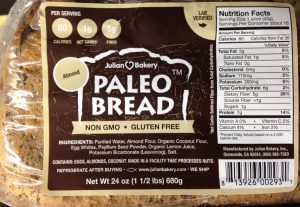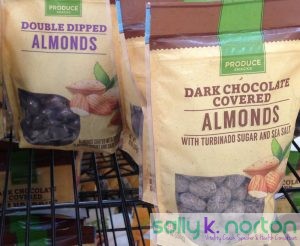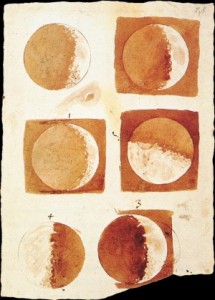Five+ Years of Low Oxalate — Reflections, Lessons, & Progress.
Back in November of 2018, I had a big anniversary: Five years since my (re)beginning and consistently sticking with the low oxalate diet (LOD)! Those of you who are considering or starting on this path of self-care might like some sort of note from your possible future. What will things be like after years of staying the course? I hope my experience will help to encourage you when things aren’t going as well as you are wanting. First let me offer some context.
A Quick Flash Back
I was in Graduate School at the University of North Carolina (UNC-CH), a patient at the medical clinic for student health. I dared to confess (to the grey-haired doctor) not only my weird symptoms but my observation that my symptoms would follow eating a variety of foods. I knew I was risking his skepticism or criticism, but I really needed help.
After eating whole wheat bread, I would feel both mentally and physically exhausted; soy seemed to cause my face to break out; and some days I would wake up with puffy eyes and a lot of fine wrinkles on my face, other days, not. He ran no tests, asked few questions, and quickly told me that my symptoms were all imaginary. He said, “you need psych-services”—three times. Belittled and soundly dismissed and by “my” doctor, I did sort of feel like I could use a shoulder to cry on. But there was no time for that with a statistics final exam the very next day!
In the meantime, my gynecologist at the UNC student clinic was taking repeat biopsies of my cervix because the tissues there looked so very cancerous. Fortunately, the results kept coming back as “chronic inflammation”. Neither of my doctors could imagine that my body was reacting to toxins, or that my immune system was in hyperdrive, agitated by irritants.
Medical “Care”
Medical practitioners (and other “experts”) have a long history of dismissing problems they don’t understand by accusing the victims of being hysterical or mental cases who need counseling. If you don’t fit their preexisting menu of “legitimate” problems, if you have too many complaints or otherwise feel sort of crummy a lot of the time, then the general attitude is: Well, you can’t be suffering from an organic illness with real causes.
They, the experts, don’t approve of conditions that don’t fit their lists or don’t conform to their assumptions or respond to symptom-hiding remedies. Their inability to help makes us malingerers, cry-babies, or one of the “worried well” (a new blanket term replacing previous labels like “female hysteria”). Likewise, family and friends can also be dismissive, or at best, at a loss as to how to be supportive of us when we struggle with a chronic mystery illness. And, few are tolerant of the idea that dietary changes might have merit.
Sharing to Teach
Given this cultural context, it must be either an act of bravery or recklessness to share publicly the depth and breadth of a multi-focal and wholly ignored illness like dietary oxalosis (oxalate toxicity). Am I foolish, brave, or reckless to admit that I had a lot of stuff bothering me that nobody could figure out? Yes, Yes, Yes. Accuse me of all three. I’m willing to stick my neck out in sharing my story for those who also suffer from a bunch of nasty problems hamstringing their lives.
How Weird is This?
Invariably, the characterization used in the medical literature for this oxalosis problem is “heterogeneous.” The symptoms of excess oxalate in the human body are indeed variable: different for the same individual at different times and different from person to person. Medical writers also use the term “asymptomatic” a lot—but that is yet another issue. The silent start of this disease might mean that things appear normal and healthy until symptoms show up later in the more problematic stages.
The bottom line, confusing as it can be, is this: The same disease looks very different in different people (and is often “silent” in the early stages). All the systems and all the tissues of the body can be affected by oxalate. All of them, every last one. On the other hand, in some people only a few body parts protest. There are no rules of toxic biology that comply with medical expectations or the handbook of medical diagnosis.
A Look at Oxalate Illness
The visible signs that oxalates are interfering with the maintenance and smooth running of our bodies don’t present specific universal patterns unique to this disease. In general, we can divide the likely factors behind this into two general categories. For one, the differing effects and severity in each person most likely reflect a person’s unique history of exposure. Here are some examples of what I mean:
- timing of intake of high oxalate foods with age and related developmental stages,
- states of wellness or infection at the time (or pseudo-infections that comes with vaccination),
- a status of injury or overuse in some area(s) of the body,
- personal nutritional and sleep habits,
- levels of physical or emotional stress,
- microbiome status, gut health,
- kidney function.
Another source of the varied individual expressions of this disease are each person’s unique vulnerabilities that come from constitutional or metabolic tendencies and factors influencing genetic expression.
Remember too that the various body parts entangled with oxalate are unlikely to hold meetings to decide who among them can be harmed by oxalate, who may be spared (or appear to be spared for now), and who can cope with their level of oxalate exposure without subpar performance.

Reflections After 5 Years on the Low Oxalate Diet
Trite as it sounds, this diet has brought me back to life. Now, life-long health mysteries are not so mysterious. After years of suffering with pain, fatigue, sinus problems and bad feet, there was the possibility of a cure—discovering the cause, putting an end to it, and reversing my chronic symptoms.
It’s Not Just My Joints that Are Happier
The crazy-long list of my health problems (involving sleep, joints, feet, chemical sensitivity, skin, etc.) has shrunk considerably! The payoff from this diet is many-fold. It has allowed me to work and live a full life again, where once that was far from the case. I feel like I’ve grown 30 years younger. My spine moves, my brain works, I can sleep, run, and play in ways that were not possible five years ago. Back then, I was debilitated—too tired to work, to think, to read, and unable to tolerate exercise without extreme fatigue for days after.
I had an explanation and I had undeniable results. But the explanation, which initially seemed more than perplexing to me, also felt like an outrageous double cross. “Healthy” foods can make you very sick? Oh yes they can!
About the Cause
The toxicity caused by too much oxalate in my diet was the result of eating real, whole foods. It was the result of abiding by the best health advice I knew: “Eat vegetables, emphasize leafy greens, eat beans in place of meat, eat walnuts for omega-3 fats and low-carb snacking”, I did all these things for years. I was very fond of vegetables even as a little kid. I loved real food, and still do.
Discovery, Frustration, and So Much to Learn
When I started oxalate-aware eating, I knew nothing about the chemistry or biology of oxalate and oxalic acid or its tendency to leave deposits in the body that needed to come out. (Neither do most doctors and nutritionists.) Knowing so little, I was shocked by all the benefits and funny reactions I was getting. I did not fully understand why this dietary change improves both new and old health problems, yet triggers rashes, eye sties, cold sores, peeling skin, or a variety of other oddities.
My scientific understanding needed a big boost, so I headed to the medical library. Information on chronic oxalate illness wasn’t simple to dig up there, either. After a lot of effort and time, I learned that oxalate is a known toxin with wide-ranging effects on the body. It has a long history of causing illness and the low oxalate diet is known to reverse illness.
Oxalate is known to collect in tissues. This phenomenon lacked much explanation except in cases when the disease is the genetic form, or the oxalate poisoning is acute. The chronic effects of either acute or chronic exposure on the body are still not well understood. Sadly, even the possibility of long-term effects is ignored by the establishment. In its entirety, the science is still waiting to be valued, explored, and understood.
Tragically, the many fascinating scientific findings about oxalate over the last 200 years are not adequately followed-up (if they are not soon forgotten) and the repeated warnings about the risks of routinely eating high oxalate foods are ignored. Of all the many problems with our understanding and recognition of oxalate-related diseases the most frustrating problem is this: Even receptive scientists or clinical workers do not demand accurate information about oxalate in foods. Without this, we cannot implement or study the effects of oxalate-aware eating. Thus, the diet cannot really be successful as a clinical tool. (Not that doctors are receptive to using an elimination diet, as they don’t wish to practice nutrition.)
A Quick Recap of Science Lessons Learned: A List
Here is a short list of some of the science about oxalate’s effects in our bodies. For more about this, please check back with my science page.
Oxalate:
- creates crystals anywhere in the body, including in the arteries, joints, bones, and thyroid gland.
- gets stuck in our tissues in idiosyncratic ways (different in each individual).
- disturbs digestive health and the function of other organs, connective tissues, and cells.
- causes muscles to lose potassium (and creates other electrolyte imbalances too), which can cause muscle knots, weakness, and heart palpitations.
- triggers immune reactions that promote inflammation, pain, and autoimmune disease.
- are toxic to nerves and the brain.
- can destroy your sleep. (This is a repeated and widespread finding from real people, I have not seen mention of oxalate specifically in the sleep literature.)
The Beginning is Just the Beginning
As is true with most illness, the condition of oxalate toxicity does not immediately end when the diet begins. Internal residues of oxalate persist. The gradual process of dismantling them can generate difficult symptoms. These symptoms are often inflammatory and typically have some consequences for the nervous system, affecting mood, attention, sleep, physical coordination. This is true for me even after five years of faithful conformity to the diet. The diet allows the healing process to continue in its own mysterious ways.

Still Not on Easy Street
But the five years of recovery have been challenging. There’s much more to it than just “eating less and getting better”, even though that’s a great place for almost anyone to start.
The healing process can be brutal in the first few years. For me, there have been days, way too many days, where the pain and despair caused me to question the extent of the benefits of avoiding oxalate. My own doubt, skepticism, or uncertainty would, at times, compound the miserable physical and mental symptoms. Despite near perfect execution of the diet, pain and ill feelings would reappear in an on-again, off-again fashion. Sometimes they rise up in the middle of a really good week and abruptly stop me in my tracks. Sometimes symptoms would linger. Those days the abyss was wide: The gulf between the struggle I was living and my hope of fully restored health framed a dismally disappointing picture. And yet, it was also fascinating, because it is undeniable that I was continuing to get better. Something powerful is going on here.
Ongoing Recovery Means Still Improving and this Means Some Suffering
The often unpleasant, recovery process is far from over. My body is still blasting away at the oxalate within. Thick, cloudy, crystal-loaded urine both coincide with and follow days of back pain, fatigue, and mental fog. Then, finally a really great day appears: mental clarity and strong supple body enjoying abundant sustained energy. Then a day of symptoms again. So it goes, up and down. The down days get more bearable and the good days more common. Still healing.
So many melodramatic symptoms! They are likely a sign of a strong vital force whipping up a storm intended to blow up and move the mess—out! After one episode passes, the healing force moves on to another junk pile to blow away. And so the process continues on and on. Up and down. Up and down. One good day is followed by 5 hard days. One good week is followed by six hard days. The trend is upward, but the line is jagged!
Is this continuing drama because of some other metabolic problem? Or is this just oxalate deposit removal work? A number of things make it hard to recognize that oxalate is the key to so much suffering. The variable symptom patterns are one factor. The lack of recognition of the implications of persistent high oxalate levels inside the body (due to the sequestering self-defense strategy used when intake is high) is another. Until we have intensive clinical research, the only good way to test this is to eat this way and learn from personal experience. You might be surprised by the benefits that will win you over.
As the body works hard undoing the mess, let’s work with the ways and rhythms of biology. Make your lifestyle supportive. Think: yoga, meditation, rest, limiting sugar and over all carbs, avoiding toxins and junk food. Other modalities (targeted supplements and sauna, for example) can round out a path to vibrant health. All of these self-care practices require constancy to yield the results that unfold gradually over time. Remember that the tortoise won the race. (Rabbits, on the other hand, push too hard, jump around, and either get lost, distracted or burnt out.)
Turn Off the Healing?
How do you moderate or turn-off the body’s impulse to clean out the mess? (We want to do this because it can be brutal.) Hopes of having some say in this requires us to understand the triggers of the clearance process. Down here in the trenches, we can only guess. The triggers seem to be low oxalate intake and being well nourished (with minerals, energy and protein). Does this mean we have to add back some oxalate in the diet? Or fast, or stop taking minerals? Perhaps a diet of 40 mg of oxalate in every meal would hold back the healing reactions? The answers may not be simple, but it would be nice if someone could study this formally. No one individual can do this and prove it a better approach. Careful testing and monitoring of many people over several years would be needed. (I have not done a statistical power calculation.) Such research would take resources and expertise that is out of reach, for now.
Challenge Testing
Some of us don’t notice the benefits or for other reasons. They are more likely to drift off the diet – especially in the early years. This drifting tends to create unintended, private (n=1) “oxalate challenge tests”. This can wake up an oxalate sufferer to the reality of it and pulls them back on course. Just a bowl of freshly picked figs, a baked potato, or a few nut bars and, wow, significant feedback from their body usually pops up—an agitated, sleepless night; too many trips to the bathroom; fatigue; achy wrists; something. It’s as if one’s previous apparent tolerance has been unmasked by the period of avoiding oxalate.
Still, by going back to shunning high oxalate foods and making smart selections among the many other food options, one can relax back into a healing path.
Where I am Today
Now, I am living a full life doing more than most people manage to do. So far, the low oxalate diet has given me a lot. See this table for a before and after comparison:
| Now | Before Low Oxalate Diet |
| Sleep is restorative (after about 10 days on the diet I started waking up feeling good). Restless legs: 95% gone and milder when it does happen. | Brain waking up 29 times every hour. Extreme fatigue, even during mornings. Restless legs (Diagnosis based on sleep lab was “Periodic limb movement disorder” and involved arm movements too). |
| I can read and think and write. | Had lost my reading comprehension and mental energy (likely due to sleep problem). |
| Fully functional feet (not seen in 30 years!), | My feet did not tolerate jumping, darting side to side, the wearing of heels, or going barefoot without aching. |
| More flexible and strong joints with very little pain. | Stiffness of joints and connective tissues; occasional random swelling and weakness of fingers, wrists, knees. |
| Quick recovery from exercise | Post exercise fatigue would last 3 -4 days |
| A seemingly better vascular system and improved lung capacity. No more hiccups. | Cold hands and feet. Mildly restricted ability to breathe deeply. Hiccups at night (often severe and painful). |
| Immune system is calmer with less inflammation overall. | Several “autoimmune” problems like indigestion, IBS, rheumatoid arthritis; “fibro” symptoms, many allergies, and allergic fatigue, puffy eye bags. |
| Bloating and belching is rare. | Unstoppable belching fits at bedtime. |
| A more youthful and regenerating body (I’m reclaiming my physical abilities.) | Felt worn out, aged, physical vitality slipping away. |
| Skin is stronger and less wrinkled. Few to no hangnails. Much tougher skin on the bottoms of my feet. | Bagging neck skin and eye area wrinkle. Frail skin especially noticeable around my nails where hangnails were constant. Tender skin on feet. |
| Less tartar; no more cavities; less tooth sensitivity (despite some significant flare-ups in the first 2 years on the diet). | Constant tartar and frequent cavities in rear molars, sensitive to sweet and cold. Chewing could be uncomfortable. |
| Few muscle knots. (Potassium supplements were required to achieve this.) | Abundant painful muscle knots in shoulders and back. |
| Increased bone density (increase of 4% at hip; 10% in back, according to DEXA scans) (Potassium may be helping with this too.) | Osteopenia. |
| Improved tolerance to chemicals and fragrances. (No long tail of fatique.) | Headaches and persistent fatigue easily triggered by breathing chemicals and exhaust. |
| Thyroid lumps and enlargement are gone. Reduced thyroid medication by half. | Lumpy thyroid and below normal thyroid levels. |
Changing Perspective
At the five-year point, I can see how far I have come. Yes, I want even more days of awesome. But being alive in this very honest way is good. After all, it is the amazing progress that emboldens me to dare hope for more. New possibilities expand across my horizons, even if some days those possibilities seem teasingly out of reach!
From this high peak of five years of recovery I can enjoy the view. I remember how far I have come. I can do so much more than before. I see so much progress. Part of “getting there” is a matter of remembering just how good you have it now. Not fighting this moment is part of making our next moments better.
Letting the process be what it is (vs demanding different results)
For those of us who are especially loaded with oxalate, the recovery process is a hard endurance challenge. The body needs to and wants to clean out and recover from decades of excessive oxalate consumption. As the body works to heal, it necessarily uses some rough techniques for blasting out oxalate calcifications. It unearths, attacks, dismantles, disintegrates, disperses and expels toxic crystals from cells and tissues. This work involves disruption of the status quo with inflammation and destruction. This can be painful, nerves don’t like it, muscles don’t like it, kidneys don’t like it. Your brain, your mood, your whole self, they all take a hit. It can be truly awful. (This is one major reason why both researchers and individuals overlook the benefits of the diet — the amount of oxalate in the blood and urine doesn’t necessarily drop consistently and the related symptoms persist.)

Don’t fight the waves, let the tide carry you forward.
Well, the bumpy healing process is what it needs to be. I may want joy, bliss, energy, and strength all the time; after all, I’ve been so good! What I get instead is occasional, unpredictable pain, wavering hope, and feelings of defeat. When these conditions prevail, it is our own expectations and impatience that erodes our confidence and threatens our resolve. Don’t give in to the downward pull of the bleak moments. Just know that it is temporary and will pass. Be willing to wait.
In the not-too-distant future, you’ll be feeling better and taking advantage of that. The bigger issue will be the tendency to take the better health for granted while neglecting the memories of just how bad things once were. Even when getting better, it is possible to focus too much on what is still not better. That is a sure path to misery.
Being Complete vs Not
Without acknowledging successful progress, the striving and wishing for physical perfection can generate a kind of illness of its own. It is an illness of discontent, defeat, and feeling incomplete. Instead, I resolve to be complete inside this day. As a personal hero of mine, Geneen Roth (a prolific author and guide for people struggling with food addiction and body image)[i], likes to teach: “ I am enough”. Likewise, this experience of today can be enough. I don’t need all that I desire to make it a good day. I need only my willingness to persist in a spirit of gratitude.
Today and tomorrow I am sticking with this. Joyfully I celebrate the miracles of being alive in an amazing body able to heal itself. I invite you to stick with it too. Look for and enjoy the miracle of healing.
Some Take-Aways:
- You are not crazy. You don’t need a doctor to validate you.
- It is not always obvious at the beginning that you are benefiting.
- The healing process for some of us carries on for years and years.
- There will be times when symptoms are in play making the benefits seem subtle, meager, or inadequate. These are not times to give up, but to resolve to stay the course.
- Not everyone has dramatic problems or healing symptoms. Still, it is common to overlook the connection between the oxalate clean-out your body is undertaking and the pain, skin issues, headaches, clumsy days, and tired days that arise in the process (even years after you started the diet).
- The pain of healing is part of the process. Six months of tooth pain, three weeks of sinus pain, periodic joint pain, a month of emotional fatigue—each will resolve on its own. You don’t need to intervene medically when your body is already taking care of you.
- Stick with it despite it all; and find ways to enjoy the ride.
- Recovery is real. This diet is a gift that has saved me and many others from a downward spiral that was undoing our lives and our sense of who we are.
My future is about living life fully in ways that were for so long compromised by pain and fatigue. Today, my bad days are so much better than my good days were before taking the oxalate out of my diet. I am convinced that my body will perform best with as little oxalate on board as it can manage.
A Brief Note of Gratitude and Thanks
This is a good time to take stock and express gratitude to everyone who made this possible. Thank you, Susan Owens[ii] and your devoted moderators, list mates, and loyal followers for sharing your stories of oxalate mobilization (“dumping”) reactions. Your recognition of this process is not only a brilliant insight, it has helped thousands.
Our current recognition of the connection between food oxalate and pain starts with Joanne Yount, founder and director the VP Foundation[iii]. For over 25 years, she has bravely, fiercely, and loyally attended her mission to test foods for their oxalate content on behalf of people with chronic unexplained pelvic and genital pain.
Let me start and end each day with a grateful heart.
Footnotes
[i] Geneen Roth https://geneenroth.com/books/
[ii] Autism Oxalate Project / Trying Low Oxalate Group: http://lowoxalate.info/
[iii] The VP Foundation: http://www.thevpfoundation.org/



















 no good at all.
no good at all.